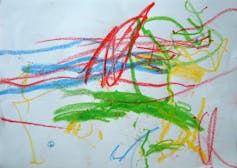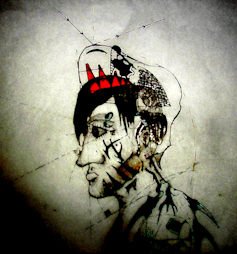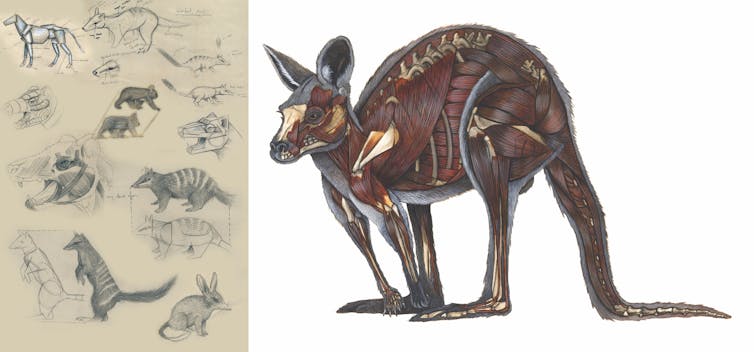Whats Somethign Art Can Teach That Regular Subjects Cant
Cartoon plays a big role in our cognitive development. It tin help us learn to write and think creatively, develop hand-eye co-ordination, hone analytic skills, and conceptualise ideas.
But drawing is rarely used every bit a tool for learning in schools. Generally, about high school teachers aren't trained in visual education.
Drawing is non something that should exist bars to art lessons – it's a skill that can play a function in many different field of study areas in school education, and later on on in the workplace.
For high schoolhouse students, drawing tin be incorporated into learning in many ways, including visual mapping, reflective thinking, organising and presenting information, and a way of communication that can transcend language barriers.
Simply the transition from primary to high school frequently brings out insecurities in i's cartoon ability. This ways students can be reluctant to use cartoon as a way of organising their thoughts .
Here's why drawing is and then important, and why kids should be taught the skill in school.
How children learn to draw
Drawings are external representations of your thinking – and when y'all were footling you were doing this all the time.
When people say they can't draw, what they actually mean is they tin can't draw something exactly as it looks. But, like whatever skill, cartoon must be trained.
It is widely believed that there are half dozen stages to drawing. These include:

Scribbling phase (2-4 years):
Children become through a process of understanding that their physical deportment can dictate the marks they make. Initially this is random scribble (kineasthetic activeness), but develops to a more controlled activity.
Pre-schematic stage (4-vii years):
Children begin to utilise shapes and symbols to explore relationships and their environment.

Schematic stage (vii-9 years):
Children develop a "schema", or consistent manner of portraying an object or person or surround. These images mostly exhibit their cognition of something.
Realistic stage (ix-12 years):
Children begin to focus on detail and realistic features in their drawings. They are conscious of their peers and the level of detail in their drawings.

Pseudo-naturalistic phase (12-xiv years):
Children begin to focus on the final product, on whether the prototype looks expert and is pleasing to peers and parents. They brainstorm to accept an understanding of three-dimensional space in their drawings. Students tin oftentimes be displeased with the outcome.

Crisis of adolescence/ creative decision (14-17 years):
In the adolescent stage, a conscious conclusion must exist fabricated to proceed drawing and engaging in visual thinking. Images created become highly individualised.
How cartoon tin help you think creatively
Drawing is used in many fields like medicine to teach observation skills in diagnosis, in anthropology as a method of taking field notes, in scientific discipline to document experiments and processes, in design to conceptualise ideas, in architecture to map out and spatialise buildings, and in engineering science to develop prototypes.
Francis Wells, a cardiothoracic surgeon, does drawings in society to map out his surgery procedure, even to the extent of cartoon with patient blood during the surgery (as seen beneath).
Sketching is the perfect tool for brainstorming and rapid idea generation or quickly recording field notes.
Visual mapping is a fashion of identifying problems and creating links. Information technology doesn't require you to draw something exactly as it is.
Learning simple visual organisation techniques like synectics, a connective thinking technique, gestalt theory, the psychology of meaningful perception, the rule of thirds equally a technique of composition, colour psychology, how we utilise colour to engage a viewer, and the principles of design tin assistance students organise and appoint data across the curriculum.
The University of Newcastle has a long-established Natural History illustration plan that has seen the collaboration between scientific discipline and illustration to visualise phenomena in the natural globe. Students use drawing and analogy to communicate findings in fields similar medicine, taxonomy and archæology.

Drawing and innovation
A company in Sydney, Meld Studios, almost purely focuses on service design, and has recently redesigned the State Library of Victoria'south services.
They use drawings to help examine the way people interact with the library in order to meet new generational needs. They visually map drawings and notes about the dissimilar interactions people accept with the library on a large forensic wall to better outline systems of service and user experience.
There arises a growing need for our education system to produce innovative and creative members of Australian society – students need to be artistic thinkers.
The key way they tin be creative is past learning to translate thoughts and ideas into real and tangible things.
Source: https://theconversation.com/why-is-teaching-kids-to-draw-not-a-more-important-part-of-the-curriculum-60379
0 Response to "Whats Somethign Art Can Teach That Regular Subjects Cant"
Post a Comment